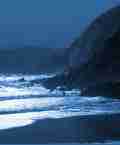 |

|
|||
The US Navy in DerryThe Petit arrived to a city already full of American sailors and Marines as well as representatives of all the Allied forces. Chief Sardo remembers how welcoming the people had been to him. He said, in fact, the first thing they did together was put on a show.
For some of the US sailors, their arrival in Northern Ireland was a literal homecoming. Warren Craig of Newburgh, New York, arrived on a destroyer, the USS Shubrick. He knew the landscape from stories his parents had told him. His father, Joseph Craig, was from the countryside near Derry and his mother, Mary Moore, was from Belfast. They had met and married in New York City and now their son was one of thousands of US sailors swarming into the ports of Northern Ireland. Warren disembarked with a talisman in his pocket, the address of his mother's childhood friend Meta Shaw.
We weren't supposed to go to Belfast, but I got on this small train and headed for my mother's friend's house. She was really surprised to see me. They wouldn't let me go; in fact, they followed me all the way back to Derry in a taxi with a huge barrage bag. They wanted to hear all my war stories and I had some to tell. I had enlisted when I was seventeen and shipped out to the Pacific on the USS Duncan. We were in the battle of Cape Esperance and we were hit fifty times in a few hours, but we sunk a Japanese cruiser, the Fuderacka. < < < Read the first part of this article. From Home Away from Home. The story of the American Army in Ireland during WWII. |
[ Back to top ]
All Material © 1999-2006 Irelandseye.com and contributors

 We had come to build the hospital. I had come over on the Queen Mary in late February. I had a nice little private state room and ate like a king. We landed in Southampton and flew on a C-47 outside of Derry, probably not too far from where my cousin landed. We were there to set up a mobile hospital for the troops. I was among the first Americans in Derry, although people told us that there had been a lot of American workers there building the port at Lisahally. This was one of those big military secrets that everybody knew. We put on a show for Mrs Churchill to raise money for Russian relief. I was a singer at the time and I sang "God Bless America". We had a lot of local talent in the show plus service personnel. We called ourselves the Creevagh Minstrels. Ironically, my cousin Amelia Earhart had also landed in Northern Ireland, but I think I had an even better time than she did.
We had come to build the hospital. I had come over on the Queen Mary in late February. I had a nice little private state room and ate like a king. We landed in Southampton and flew on a C-47 outside of Derry, probably not too far from where my cousin landed. We were there to set up a mobile hospital for the troops. I was among the first Americans in Derry, although people told us that there had been a lot of American workers there building the port at Lisahally. This was one of those big military secrets that everybody knew. We put on a show for Mrs Churchill to raise money for Russian relief. I was a singer at the time and I sang "God Bless America". We had a lot of local talent in the show plus service personnel. We called ourselves the Creevagh Minstrels. Ironically, my cousin Amelia Earhart had also landed in Northern Ireland, but I think I had an even better time than she did.